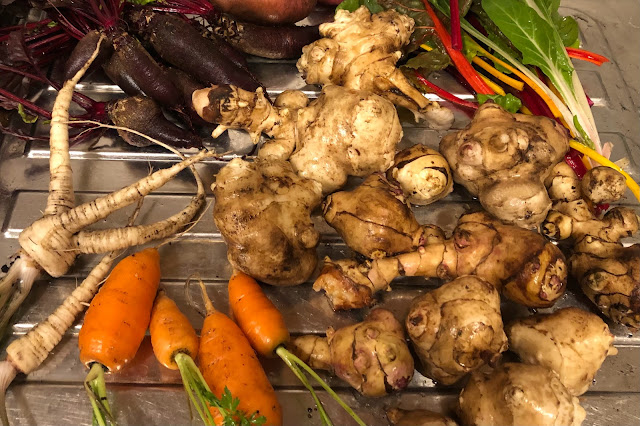It's been a pretty disastrous year for veg growing in my patch and this morning, late July, it feels positively autumnal. (Not in a good way.) But I've been through my seed packets and found potential for quite a lot of late summer sowings. By taking advantage of the (relatively) warm and wet weather currently in play here in London, I'll have quick growing crops in the next few months, plus winter leaves and spring harvests.
 |
| Just a small selection of what can be grown this autumn! |
I don't usually give much thought to late summer sowing at this time of year (there's usually plenty more to be getting on with, like picking, freezing, pickling) and I also have balcony sown crops waiting to go out (kale, beetroot, spring onions) ... but this year there's precious little to harvest. However, accentuating the positive, I'm excited to realise exactly how much growing is still possible.
Erring slightly on the optimistic side, I've sorted food seeds into chronological piles: Last Chance for sowing, Sow By end of August, Sow By the end of September and Balcony Baby Leaves. This way, I can pace myself and sow when I have/make time. And, of course, there's also seeds to sow in the next few weeks for flowers.
Last Chance ...
Dwarf Beans. As my broad beans produced only a few usable pods and my french and runner beans were annihilated by a dastardly extreme heat:no water combo, I'm going to take a gamble on sowing some Dwarf Beans. The best results are from sowing between May and early July but as they're fast maturing, I may just get a harvest by the end of October. I'm sowing Elba from Mr Fothergill seeds for round stringless pods and 'Atlanta' from Johnsons seeds for flat pods that promise to have a crisp texture and excellent snap. Yum!
I've also added peas to this category as I remember sowing Kelvedon Wonder peas late one year and having many pods to pick before winter. This time I'm trying 'Champion of England' from D T Brown seeds.
And I mustn't forget carrots. I was harvesting a summer sowing in December last year so it's well worth sowing these, particularly Amsterdam Sprint (Mr Fothergill seeds) for sweet baby carrots. These should be ready in under 3 months, so I may do a couple of successional sowings.
Balcony Baby Leaves ...
aka Cut and Come Again. Always useful to have an instant salad bar to hand but it doesn't matter if this doesn't go to plan, it's a good way to use up seeds which may or may not still be viable ... and seeds that should have been sown much earlier. So for baby salad leaves, into my window box planters will go peas (for pea shoots), spinach, red kale, Cavolo Nero kale, mustard leaf, little gem lettuce and fancy salad leaves. I could also throw in a few herb seeds like chervil and coriander.
Sow By End of August ...
It looks like I'll be busy during the next few weeks (the sooner sown the better). Pink stemmed chard, winter spinach, spring onions, radish, saltbush (Sea Orach), lettuce, lamb's lettuce (corn salad) and Kohl Rabi are all on my list. Another early veg patch success was a bed full of parsley, vigorously sown by the children here, which flourished after a downpour of warm rain shortly after sowing. So parsley (curly and flat leaved) is going in, as is Coriander (crops in 6 weeks, allegedly).
Sow by the End of September ...
According to packet instructions, it's okay to sow seeds for kales, pepper cress, onions and breadseed poppies from now to the end of September. These won't be ready this year but I can look forward to earlier crops next year. And if there's any space left, I'll pop in some rocket, radishes and turnips for an early winter crop this year.
Flowers ...
It's well known that intercropping flowers with veg not only makes the veg patch pretty but has the added benefit of keeping pollinators happy. Flowers that drop their seeds in late summer can be sown now - foxgloves, nigella, poppies, calendula, cerinthe and poached egg plant (Limnanthes). The nigella I'm sowing is called Black Caraway (Mr Fothergill seeds) - the seeds can be used in cooking and I save the seed pods for decoration.
After the challenges of this year, I admit I have entertained thoughts of planting perennial flowers and having done with it. But could I bring myself to do that? Probably not. My secret passion, like most veg growers, is munching my way around the garden, nibbling at gooseberries, peas, radishes, et al. And the satisfaction in bringing freshly harvested fruit and veg - yes, even courgettes - back to the kitchen is addictive. And so, of course, the work continues.













